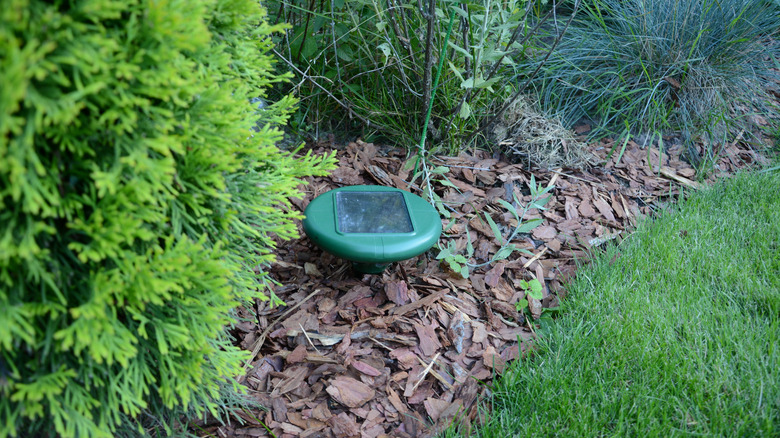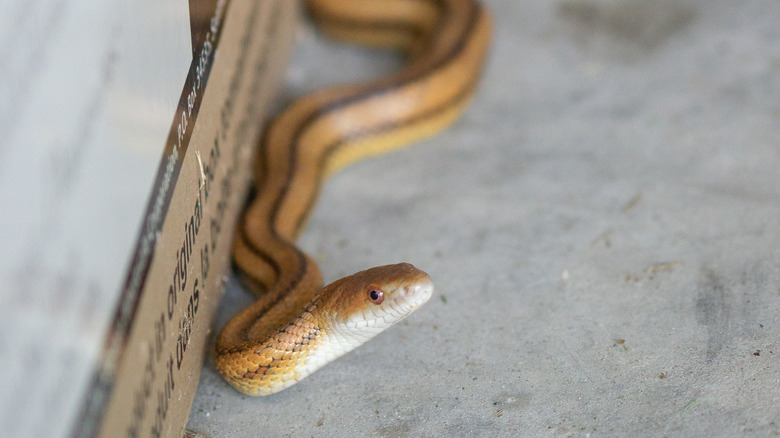Think Twice Before Using Ultrasonic Pest Control To Repel Snakes
We all have our favorite wildlife animals that we don't mind seeing in the yard, be it deer, wild rabbits, or even little, fluffy squirrels. One animal, however, that many people agree is a hard no-no is the snake. Snakes have a bad reputation, and, although they usually keep to themselves, we still don't want them around the house in any way. Not only do they target smaller animals like our beloved pets, but some of them happen to be venomous and can hurt us.
People are constantly looking for ways to get rid of the snakes in their yard and one high-end, "techy" way to do so is by using an ultrasonic device. Unfortunately, contrary to popular belief and advertisements, there is no concrete evidence that they even work. When it comes to repelling snakes via sound, you have to understand that they don't hear in the same way that we humans do. Snakes' hearing is not one of their primary modes of communicating with their environment. They lack outer ears and tympanic membranes, unlike dogs and cats who have great hearing.
Snakes respond mostly to vibrations of lower frequencies, according to a study on how snakes respond to airborne and ground-borne sounds. Unlike us humans who are most sensitive to frequencies around 1000 to 3000 Hertz, most snakes are sensitive to lower vibrations of about 40 to 600 Hertz, depending on the species. The thing is, ultrasonic devices by definition emit high-frequency sound waves of about 20,000 Hertz. Snakes can't hear that high.
Don't expect snakes to flee from your ultrasonic repellent
Most ultrasonic snake repellents claim to work by emitting frequencies that induce ground vibrations that make the snake too uncomfortable and wary to even move in that particular area. While research does indicate that snakes monitor predator and prey movement vibrations, experts put the repellents to an actual test in an informational video published on Facebook by 7News Adelaide and proved their inefficacy. The video clearly shows highly dangerous snakes casually lounging around the $50 repellents, not showing any signs of distress, but rather, the opposite. Some of the snakes slithered right past them in complete disregard while some were even attracted to the heat produced by the devices and nestled beneath it.
If you have a snake problem in your house, the most ideal way to remove the creature is to catch it and hand it over to animal authorities. You cannot rely on vibrations you can't even hear yourself. Your best bet is to create a DIY glue trap to catch the snake humanely before it does any damage. This is done by fitting a tray filled with glue into a sizable plastic box. Place some snake bait such as eggs inside the box and wait for the snake to find it and get stuck. Contact a professional pest control to handle the rest. If you're not comfortable dealing with a snake at all, then skip the trap and let a pro deal with the situation.
Ways to prevent snakes from getting near you
Since ultrasonic repellents don't work on snakes, it's safe to say that they can't be used as a preventive measure, either. If you live in a snake-prone environment and want to shield your home from the slithering, scaly creatures, you have to ready your battlements. One of the best ways to repel snakes from your home is by erecting physical barriers rather than sound ones. Snakeproof fencing should go around your yard and underground by a minimum of one foot to deter the legless critters.
Bar snakes from entering your home by making sure your windows and doors are closed at appropriate times. Seal up any cracks in your walls or doors that lead outside. The snakes have to come in somehow, so make sure they have a hard time doing so. Similarly, make sure your lawn gets proper maintenance. Snakes love to hide in tall grass, so mow it down.
Another important preventive approach is ridding your house of other pests, especially those considered food by snakes. Animals such as rodents, frogs, and other small reptiles like lizards are prey for most snakes and can be found in a lot of yards. Once you tackle the animals, you should also get rid of any standing water sources such as indoor pipe leaks or shallow puddles in your yard. Snakes need a drink of water, too, so removing them could discourage them from coming over.


